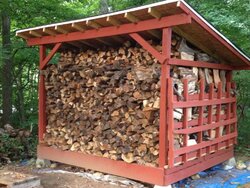I am hoping to build or at least start my wood shed this weekend. It's going to be built attached to my current shed and I will be replacing the roof on the shed and extending the new roof off to one side which will be my wood shed. It's going to be either 10x10 or 10x8 on level ground with an interior height of about 8'. The person helping me is saying that I should go with (6) 12" sonotubes for the piers. These 6 piers will be evenly spaced under the the wood shed. (3) on the far left, (3) in the middle and the remaining side will be resting on the concrete slab of my existing shed.
Are these piers overkill? I plan on stacking the wood as high and as tight as I can (roughly 5 cords). I also don't want to dig this many holes if I don't need to as the ground where i live is mostly rock.
Are these piers overkill? I plan on stacking the wood as high and as tight as I can (roughly 5 cords). I also don't want to dig this many holes if I don't need to as the ground where i live is mostly rock.



